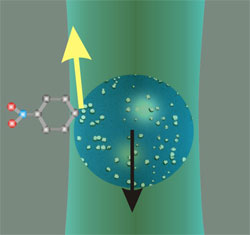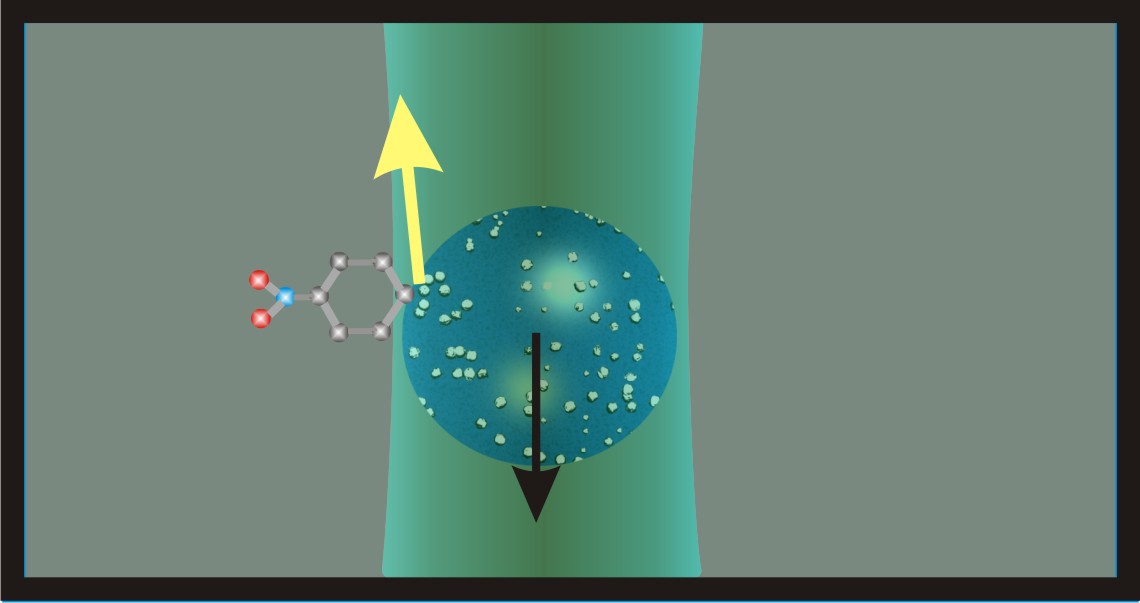Bead’s Glow Creates Recoil
Radiation pressure–the force light exerts on matter–is so slight that it’s usually evident only in the atomic world or in the vacuum of space. Now a pair of studies published in the 27 February Physical Review Letters and the October Physical Review E suggests that a common laser-and-microscope technique is sensitive enough to measure the recoil felt by a micron-sized silica bead emitting light from its surface. Researchers used lasers to trap a bead and measure the forces acting on it, while simultaneously recording the light generated by molecules coating the bead’s surface. They report that the forces acting on the bead were correlated with the intensity of emitted light, as would be expected if emitted photons were nudging a bead back and forth like the exhaust from tiny thrusters.
The experiments used a type of photonic force microscopy (PFM), which is used to measure forces acting on microscopic beads suspended in liquid. PFM specialists first isolate a bead in the focus of a laser beam, creating an optical trap. The bead then acts like a tethered buoy. Liquid molecules randomly nudge it, but the trapping laser exerts a spring-like force that draws the bead back to its starting point. By tracking the position of the bead using a separate laser, researchers can measure the size of the bead’s jostling motions in the trap, which tells them the strength of the fluctuating forces acting on it. Some researchers have observed signs of radiation from the laser alone pressing on trapped beads, but those beads were absorbing light rather than emitting it.
A team led by Dmitri Petrov of the Institute of Photonic Sciences in Barcelona, Spain, wanted to see if PFM was sensitive enough to pick up the recoil of beads trapped in a solution of photon-emitting molecules that adhere to a bead’s surface. To maximize the rate of photon emission, the team dotted its beads with clusters of silver atoms, mimicking metal nano-spheres that have been found to enhance the glow of nearby dye molecules.
For their first experiment, published in February, the researchers trapped two-micron-wide beads in a solution of the dye crystal violet. The dye molecules convert a small amount of incoming light energy into atomic vibrations and then emit light of slightly longer wavelength (Raman scattering). The correlation was clear: when the team switched on the “pump” laser to activate the dye, the bead’s displacement, averaged over many fluctuations, increased, corresponding to forces of up to 240 femtonewtons (1 femtonewton = newtons). The researchers calculated the power of light emitted from the bead at 1 microwatt, which is “quite amazing,” says Satish Rao, a post-doctoral fellow in the Barcelona lab. “No one else has been able to say how much light really comes off this material.”
In the follow-up experiment, Petrov and his colleagues tracked the bleaching, or gradual fading, of the fluorescent molecule rhodamine, which glows yellow under green light. In photobleacing, fluorescent molecules fade strongly after a few tens of seconds. Accordingly, when the team focused a green laser on the bead, it experienced a sudden force of about 300 femtonewtons, which quickly plummeted along with the fluorescent light intensity. “On the face of it, it’s pretty fantastic,” says optical trapper David Grier of New York University. The recoil force of photons is the basis for laser cooling of atoms and molecules. “Seeing it for a macroscopic object strikes me as something of a tour de force,” he says.
Rao says this type of PFM could offer a more precise way of measuring the efficiency and intensity of other light-emitting molecules, including the bleaching of fluorescent dyes. Lukas Novotny, a nano-optics researcher at Rochester University in New York state, doesn’t see any immediate applications. “For me the beauty is really the possibility of measuring light through a mechanical force.” He says he is looking forward to follow-up experiments that quantify the correlation between the measured force signal and the fluorescence emission. “A 100 percent correlation would prove that the two share the same origin.”
–JR Minkel
JR Minkel is a freelance science writer in New York City.





